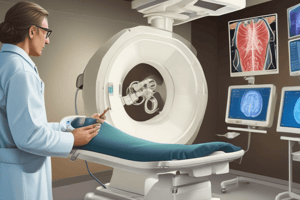Podcast
Questions and Answers
Match the following terms with their corresponding descriptions:
Match the following terms with their corresponding descriptions:
Control Panel = Adjustment Technique Lock = Exposure Adjustments High Dose Image = Pulsed Fluoroscopy Continuous Fluoroscopy = Increased mA Magnification = Mirror Image + Flip Superior/Inferior = Reduce Motion Blur Iris Collimator Adjustment = Rotate Paired Filters
What is fluoroscopy?
What is fluoroscopy?
- A type of medical imaging that shows a continuous X-ray image on a monitor (correct)
- A type of magnetic resonance imaging
- A type of ultrasound imaging
- A type of computed tomography imaging
What are two advantages of fixed systems over mobile systems in fluoroscopic imaging?
What are two advantages of fixed systems over mobile systems in fluoroscopic imaging?
More reliable x-ray generators and often better radiation protection
Digital Subtraction Angiography (DSA) can only work on anatomy that is not moving.
Digital Subtraction Angiography (DSA) can only work on anatomy that is not moving.
Contrast media that has a higher atomic number than surrounding tissues and attenuates more x-rays is known as ____________.
Contrast media that has a higher atomic number than surrounding tissues and attenuates more x-rays is known as ____________.
Match the following types of contrast media with their descriptions:
Match the following types of contrast media with their descriptions:
Flashcards are hidden until you start studying
Study Notes
Fluoroscopic Imaging
- Fluoroscopy is a type of medical imaging that shows a continuous X-ray image on a monitor, similar to an X-ray movie.
Applications of Fluoroscopy
- Orthopaedic: Arthrograms, theatre procedures
- Angiography: Cardiac, cerebral, peripheral
- GI Tract: Barium swallows, meals, and enemas
- Endoscopy: ERCP, OGD
- Urology: Ureteroscopy, nephrostomy insertions, PCNL
- Interventional Radiology: Line insertions, Embolisations, PTC
Fixed Systems
- Installed in a specific room or suite
- Typically used for longer screening cases
- Variety of styles: floor mounted, ceiling mounted, biplane
Mobile Systems
- Portable
- Used to support theatre cases and shorter or less complex interventions
- Can be moved between theatres
Comparison of System Advantages
- Mobile Systems: Does not require custom room design, can be moved between theatres, often better radiation protection
- Fixed Systems: More reliable x-ray generators, often more features, room is designed to allow uninhibited movement of c-arm
X-ray Generation
- Mechanism similar to conventional x-ray systems
- Modes: Continuous fluoroscopy, Pulsed fluoroscopy, High-Dose “Acquisitions”, Single high-dose image
Anode Heat Dissipation
- High-speed rotational anodes
- Oil or water cooled systems
- Range of focal spot sizes to balance detail with anode heating depending on application
Image Intensifier
- X-rays pass through the patient and reach the input phosphor
- Input phosphor emits light, which reaches the photoemissive layer, emitting electrons towards the anode
- Electrons reach the output phosphor, producing an amplified light signal
- Light signal is recorded by a camera
Flat Panel Detectors (FPDs)
- Similar to plain film direct digital receptors
- Input x-rays converted into electric via a Selenium photoconductor
- Charge transmitted to a thin-film transistor (TFT) array
- Array arranged in a matrix with each transistor mapped to a pixel
Comparison of Image Intensifier and Flat Panel Detectors
- Advantages of FPDs: Lower dose, greater field of view, higher image quality
- Disadvantages of FPDs: Higher initial cost, size of receptor can impact maneuverability
Contrast Media
- Positive Media: Radiopaque, higher atomic number, attenuates more x-rays, appears “Hyperdense” on image
- Negative Media: Radiolucent, lower atomic number, attenuates less x-rays, appears “Hypodense” on image
Double-Contrast Imaging
- Uses both positive and negative contrast together
- Can be used in Barium meal and Barium Enema investigations
Digital Subtraction Angiography (DSA)
- Process used in angiography to remove distracting detail and anatomical structures from the image
- Operator acquires images before injecting contrast, and computer system creates a “mask” demonstrating the background anatomy
- Subsequent images are subtracted from the mask, leaving only the new information visible on the screen
Biplane Systems
- Digital fluoroscopy systems with multiple c-arms
- Allow simultaneous images in multiple planes
Radiation Protection
- Room designated as a “Controlled Area”
- Warning signs, local radiation rules, and workers wear lead PPE
- Methods to reduce dose: Low dose fluoroscopy setting, collimation, reduce exposure factors, reduce SID, staff stand further from primary beam, reduce pulse/frame rate, use shallow angles, lead shielding, staging the procedure
Exposure Factor Control
- Automatic Brightness Control (ABC): Adjusts kVp and mAs to maintain a present brightness level
- Automatic Dose Rate Control (ADRC): Algorithmically controls exposure factors based on anatomical thickness and applies initial setting based on the program selected
Image Quality – Further Considerations
- Screen position, cleanliness of screens, lighting of the room, display settings
- Collimation: Reduces irradiation of unnecessary anatomy, reduces scatter, and affects the full circumference of the image
- Filtration: Reduces skin dose, reduces “flare” on the image, improves visibility
- Exposure Lock: Locks the exposure at a previously used level or overrides and sets manual parameters to prevent unnecessary compensation for high-density objects
Studying That Suits You
Use AI to generate personalized quizzes and flashcards to suit your learning preferences.




